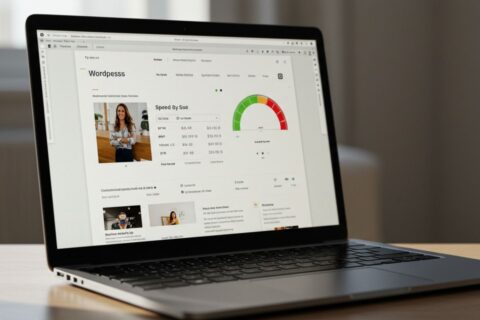Website speed has become a make-or-break factor for online success. Whether you’re running an e-commerce store, a personal blog, or a corporate site, fast load times are crucial for keeping visitors happy, improving conversions, and boosting your rankings on Google. But when it comes to making your site faster, should you rely on AI-powered solutions, stick with tried-and-true manual methods, or use a mix of both? In this guide, we’ll explore AI vs. manual website speed optimization and help you discover which approach delivers the best results in 2025.
What is Website Speed Optimization?
Website speed optimization is the process of making your site load as quickly as possible. This involves analyzing what slows your site down and taking steps to fix those issues. Fast websites keep users engaged, reduce bounce rates, and even improve your search engine ranking. In today’s digital world, even a delay of one or two seconds can send visitors elsewhere.
Key Factors Influencing Website Loading Speed:
- Images: Large, unoptimized images can drag down your site speed.
- Scripts: Heavy or unminified JavaScript and CSS files increase loading time.
- Hosting: Your server’s speed and reliability matter, a lot.
- Plugins: Too many plugins or poorly coded ones can bloat your site.
- Caching: Proper use of caching stores data and makes repeat visits much faster.
Another important consideration is Google Core Web Vitals, which are a set of metrics Google uses to evaluate page speed and user experience. Optimizing for these metrics is now essential for SEO and user satisfaction.
Manual Website Speed Optimization: How Does It Work?
Manual website speed optimization means you or your developer handle all the speed fixes by hand. This approach has been the standard for years and offers full control over your website’s optimization process.
Common Manual Optimization Tasks:
- Image Compression: Reducing file sizes without losing quality.
- Code Minification: Removing unnecessary characters and spaces in CSS, JavaScript, and HTML files.
- Lazy Loading: Loading images and media only when they appear in the user’s view.
- CDN Setup: Distributing your site’s files across global servers to serve users from the nearest location.
- Database Cleanup: Removing unnecessary data to speed up queries.
Pros of Manual Methods:
- Granular Control: Every change is made according to your specific needs.
- Custom Solutions: You can address unique issues with tailor-made fixes.
- In-depth Understanding: You know exactly what’s happening and why.
Cons of Manual Methods:
- Time-Consuming: Manual optimization can take hours or days.
- Requires Expertise: You need technical skills or must hire an expert.
- Human Error: Mistakes can break your site or leave issues unresolved.
Manual website speed optimization is best suited for those who want complete control and have the resources to manage ongoing technical tasks.
AI-Powered Website Speed Optimization: How Does It Work?
In 2025, AI website speed optimization is more accessible than ever, thanks to automated site optimization tools and page speed AI tools that analyze your website, identify bottlenecks, and fix them automatically.
Also Read: AI Tools That Optimize Website Speed Automatically
How Do AI Tools Work?
AI-powered tools scan your site for common and advanced speed issues. Using machine learning algorithms, these tools continuously learn from thousands of websites to find the most effective solutions for yours.
Examples of AI Optimization Tasks:
- Real-Time Image Optimization: Automatically compresses and converts images to the best format for speed.
- Automated Script Management: AI detects heavy scripts and loads or delays them intelligently.
- Intelligent Caching and CDN Routing: AI chooses the best caching strategies and routes users to the fastest servers.
- Predictive Load Balancing: AI anticipates traffic spikes and prepares your server resources in advance.
Pros of AI Methods:
- Automation: Most tasks run on autopilot, saving you time.
- Efficiency: AI often finds and fixes issues faster than humans.
- Scalability: Works seamlessly for sites with hundreds or thousands of pages.
- Continuous Improvement: AI keeps optimizing as your website grows.
Cons of AI Methods:
- Limited Customization: Some tools may not address very specific needs.
- Tool Dependency: Your results rely on the AI provider’s capabilities.
- Potential Security Concerns: Entrusting sensitive data to third-party AI tools requires trust in their security measures.
AI website speed optimization is ideal for business owners and marketers who want hands-off, ongoing performance improvement without deep technical involvement.
AI vs. Manual Website Speed Optimization: Direct Comparison
Here’s a quick side-by-side look at the two approaches:
| Feature | Manual Optimization | AI-Powered Optimization |
| Speed | Slow, requires manual work | Fast, real-time adjustments |
| Cost | Potentially high (expertise) | Usually monthly subscription |
| Accuracy | High if expert-driven | High for common issues, improving for advanced ones |
| Scalability | Difficult for large sites | Handles large, complex sites easily |
| Customization | Full control | Limited by tool’s features |
| Maintenance | Ongoing manual effort | Mostly automatic updates |
Real-World Scenarios:
- Use AI Tools: For standard business websites, e-commerce stores, and blogs wanting quick, reliable speed boosts.
- Use Manual Methods: For highly customized sites with unique functionality or strict security requirements.
- Combine Both: Use AI tools for ongoing, automatic improvements and manual tweaks for special cases.
Case Study Example: A mid-sized e-commerce site used an AI speed optimization tool for automated image and script management, reducing average load time from 4 seconds to 1.5 seconds in just two days—something that would have taken a developer weeks to achieve manually.
Which Approach is More Effective in 2025?
The effectiveness of AI vs. manual website speed optimization depends on your website’s needs and your available resources.
Performance Outcomes:
- AI tools now rival or outperform manual methods for most standard speed fixes.
- Manual tweaks may still win in highly custom or complex environments.
Usability and Maintenance:
- AI solutions require minimal intervention, set and forget.
- Manual requires constant vigilance and skill updates.
Best for Different Types of Websites:
- E-commerce & Blogs: Benefit most from automated site optimization tools.
- Large Enterprises & Custom Sites: May need a hybrid approach.
- Portfolios & Small Sites: Either method works, but AI offers faster results.
Future Trends:
- AI will become smarter, handling more complex tasks with better customization.
- Hybrid approaches—using AI for routine jobs and manual for advanced tweaks—are likely to become the new standard.
How to Choose the Right Method for Your Website?
Here’s how to decide:
- Assess Your Budget: Manual optimization can be expensive; AI tools typically charge monthly.
- Check Your Technical Skill: If you’re not a developer, AI tools are much easier.
- Consider Website Size: Large or frequently updated sites benefit more from AI.
- Business Goals: If speed is mission-critical, consider combining both for best results.
Recommended Tools
- Manual: GTmetrix, Google PageSpeed Insights, WP Rocket (with manual config)
- AI-Powered: Nitropack, Cloudflare’s Auto-Optimize, WP Engine’s Smart Plugin Manager
Steps to Get Started
- Analyze your current site speed (use tools like Google PageSpeed Insights).
- Try a reputable page speed AI tool for automatic improvements.
- Review results, then manually optimize anything the tool can’t handle.
Conclusion:
When comparing AI vs. manual website speed optimization, there’s no one-size-fits-all answer. For most websites in 2025, AI-powered optimization provides faster results, less hassle, and ongoing website performance improvement. However, manual optimization still has its place for complex projects and those seeking full control. The best strategy? Leverage automated site optimization tools for day-to-day speed gains, then apply manual tweaks for the final polish.
Also Read: Dark Mode and Performance: Does It Really Make Your Device Faster?
FAQs
Is AI-based website speed optimization safe for my site’s data?
Yes, most reputable page speed AI tools use strong security protocols, but always check the provider’s privacy policy and data handling practices before integrating.
Can I combine manual and AI optimization for the best results?
Absolutely! Many experts recommend using AI for automated tasks and manual tweaks for unique needs. This hybrid approach offers both speed and control.
What are the most common mistakes in manual website speed optimization?
Forgetting to back up before changes, not testing across devices, and overlooking plugin or script conflicts are frequent issues. Manual work demands careful planning.
How often should I optimize my website speed?
Continuous optimization is ideal. Automated site optimization tools can run constantly, while manual checks should be scheduled monthly or after major updates.







